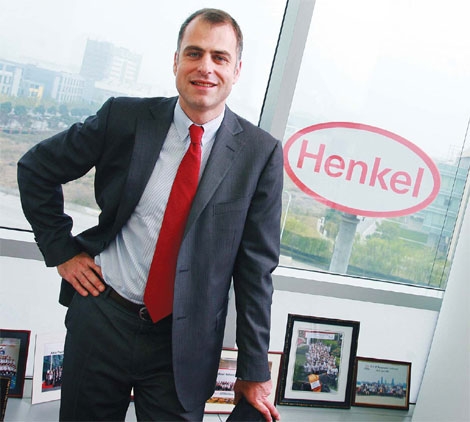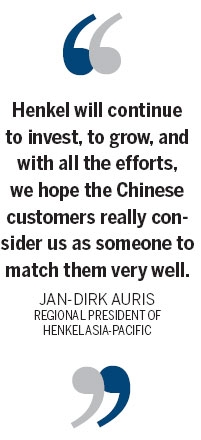Special
German giant sticks to Asia
Updated: 2010-12-24 13:28
By Wang Ying (China Daily European Weekly)

Jan-Dirk Auris, regional president of Henkel Asia-Pacific, says the company will build the largest adhesive factory in China. Provided to China Daily |
Henkel set to ride sales growth in Asia-Pacific
Henkel, the German business group behind leading brands such as Schwarzkopf, Loctite, Teroson, Pritt and Pattex, has achieved significant success in the European and United States markets over the past decades and it is now aiming to be more Asia-focused, a senior executive from the company says.
"Henkel started from being a German company to a very international company over the last 20 years, and we now want to make Henkel an Asian company," says Jan-Dirk Auris, regional president of Henkel Asia-Pacific.
Auris witnessed the change during his 25 years at Henkel. "When I started in 1984, 50 percent of the workforce worked in Germany, and 50 percent worked abroad. By now only roughly 10 percent works in Germany," Auris says.
Sales growth in the Asia-Pacific region has outpaced those from Europe, the Middle East, Africa and North America.
In the past three years, Asia-Pacific region sales almost doubled, contributing around 15 percent of Henkel's global sales, Henkel's third-quarter report shows.
|
|
The Asia-Pacific region has experienced double-digit growth on average over the past two decades. Growth remained at 14.9 percent during the third quarter, with 579 million euros of organic sales. Henkel's sales in the Asia-Pacific region (including Japan, Australia and New Zealand) is more than two times that of GDP growth in the area, which sees an average GDP growth of 6 percent.
Sales in the Asia-Pacific region almost doubled in the past three years by contributing around 15 percent of Henkel's global sales, according to Henkel's third-quarter report.
"China is the most important market in this region, and it is growing almost twice as fast as the overall Asia-Pacific region," Auris says.
Henkel plans to draw 45 percent of its global revenue from the emerging economies by 2012, up from the current 42 percent.
"We are pretty confident that after two years, a little bit less than half of Henkel's revenue will come from emerging countries," Auris says.
As the world's No 1 adhesive company, Henkel generated about 6.2 billion euros in sales in 2009 from the adhesive business globally. China is the second-largest market after North America.
"This is particularly amazing because if you go seven years back, China was not even in the top 10," Auris says. The adhesive sector accounts for 50 percent of Henkel's total business globally. The company's other businesses include cosmetics and detergents.
Auris says that Henkel will build the world's largest adhesive factory in China. "We have already moved ahead for land selection, and it's going to be the largest adhesive plant within Henkel," Auris says.
He says he cannot reveal too much about the factory because the final decision has yet to be made, but he suggested that the investment will be in the middle range of a "double-digit" million euros.
China's adhesive market growth rate stayed above 12 percent over the past eight years, higher than the same period's GDP growth. The nation's demand for adhesive products will increase at more than 12 percent annually over the next few years.
The nation's total demand for adhesives will reach 4.95 million tons in 2011, with sales at 71 billion yuan (8.09 billion euros), which will make China the world's largest adhesive manufacturer and the third-largest adhesive market in terms of revenue, according to the China National Adhesives Industry Association.
In stark contrast with the potential of China's adhesives market, there are about 3,500 domestic adhesive manufacturers, mostly small-sized and producing products for low- and medium-end users, leaving the much more profitable high-end market for international giants such as Henkel, says Xiong Jie, an industrial analyst from Huatai Securities.
In 2007, Henkel moved its Asia-Pacific headquarters, together with one of four R&D centers, to Shanghai. The building, excluding laboratory equipment, cost about 35 million euros.
The majority of the development in Shanghai is for China but goes beyond it, Auris says. By leveraging knowledge from the global platform, the China team can immediately come up with solutions that are more tailored and suitable for local demand, he says.
Innovation is the bloodline of Henkel, Auris says. Worldwide, 3 percent of its sales revenue was used for innovation in 2009. The company realized 13.57 billion euros of sales last year, making product innovation investment many times more than its competitors'.
"In China, there are many successful emerging companies. We want to build close partnerships with them, understand what they are looking for, their requirements and then provide our products and solutions," Auris says.
Henkel's long-term plan is to be perceived by Chinese customers as a company that matches local talent with global resources.
"We expect to provide more sustainable solutions to significantly help our customers and we also expect to have many more talent in China going beyond Asia," Auris says.
"Henkel will continue to invest, to grow, and with all the efforts, we hope the Chinese customers really consider us as someone to match them very well."
E-paper

Ear We Go
China and the world set to embrace the merciful, peaceful year of rabbit
Preview of the coming issue
Carrefour finds the going tough in China
Maid to Order
Specials

Mysteries written in blood
Historical records and Caucasian features of locals suggest link with Roman Empire.

Winning Charm
Coastal Yantai banks on little things that matter to grow

New rules to hit property market
The State Council launched a new round of measures to rein in property prices.

